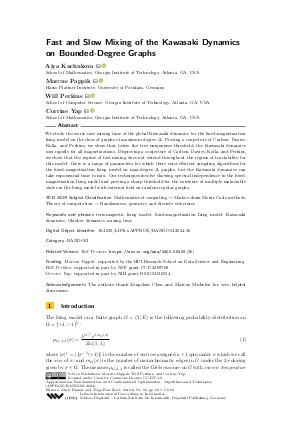LIPIcs.APPROX-RANDOM.2024.56.pdf
- Filesize: 1.13 MB
- 24 pages

 Creative Commons Attribution 4.0 International license
Creative Commons Attribution 4.0 International license

We study the worst-case mixing time of the global Kawasaki dynamics for the fixed-magnetization Ising model on the class of graphs of maximum degree Δ. Proving a conjecture of Carlson, Davies, Kolla, and Perkins, we show that below the tree uniqueness threshold, the Kawasaki dynamics mix rapidly for all magnetizations. Disproving a conjecture of Carlson, Davies, Kolla, and Perkins, we show that the regime of fast mixing does not extend throughout the regime of tractability for this model: there is a range of parameters for which there exist efficient sampling algorithms for the fixed-magnetization Ising model on max-degree Δ graphs, but the Kawasaki dynamics can take exponential time to mix. Our techniques involve showing spectral independence in the fixed-magnetization Ising model and proving a sharp threshold for the existence of multiple metastable states in the Ising model with external field on random regular graphs.





Feedback for Dagstuhl Publishing